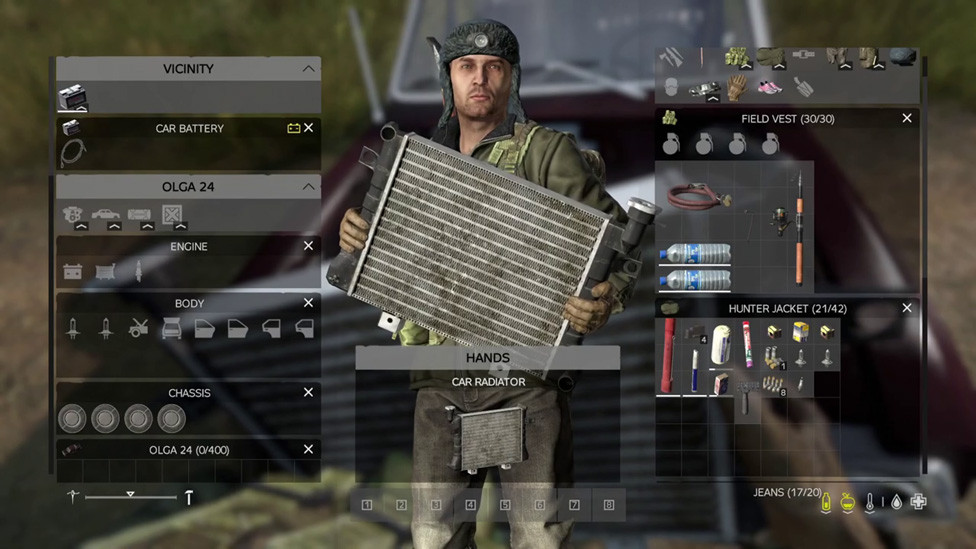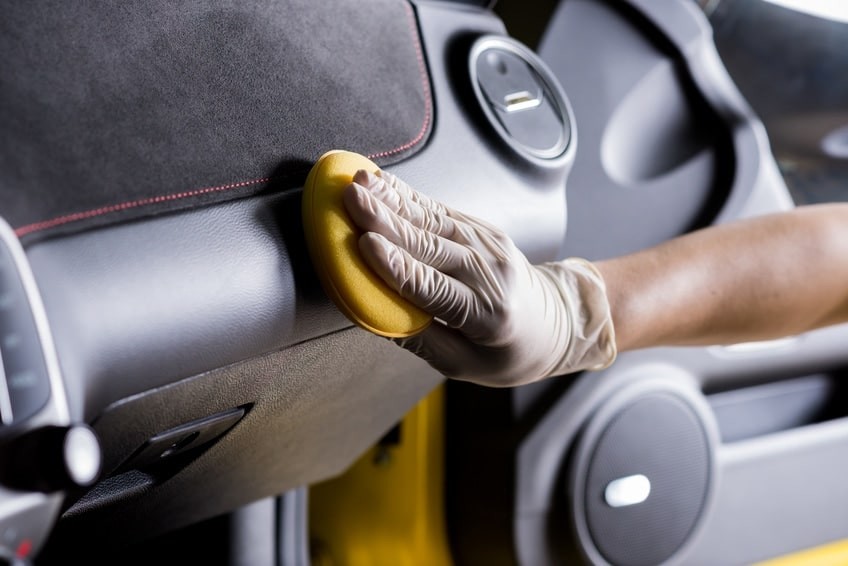How To Fix Oxidized Car Paint: A Comprehensive Guide
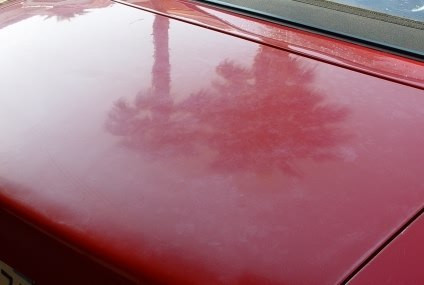
Oxidized car paint is a common problem, but with the right techniques and tools, you can restore your vehicle’s shine and protect it from further damage. At CARDIAGTECH.NET, we provide the equipment and knowledge you need to tackle this issue head-on, ensuring your car looks its best. From understanding the causes of oxidation to mastering the restoration process, we’ll cover everything you need to know about fixing oxidized car paint. Remember to protect your investment with preventative measures, keeping your car looking pristine for years to come with the help of automotive refinishing and car detailing.
1. Understanding Car Paint Oxidation
1.1 What is Car Paint Oxidation?
Car paint oxidation is the deterioration of the paint’s surface due to exposure to oxygen, UV rays, and environmental pollutants. Over time, this process causes the paint to lose its gloss, become dull, and eventually develop a chalky appearance. Oxidation primarily affects the clear coat layer, which protects the underlying color coat.
1.2 Causes of Car Paint Oxidation
Several factors contribute to car paint oxidation:
- UV Radiation: Prolonged exposure to sunlight is the primary cause. UV rays break down the chemical bonds in the paint, leading to oxidation.
- Environmental Pollutants: Acid rain, industrial fallout, and road salts can accelerate oxidation by corroding the paint surface.
- Lack of Maintenance: Infrequent washing and waxing allow contaminants to accumulate on the paint, speeding up the oxidation process.
- Extreme Weather Conditions: High temperatures and humidity can exacerbate oxidation.
1.3 Identifying Oxidized Car Paint
Recognizing the signs of oxidation early can help you address the issue before it causes significant damage. Key indicators include:
- Dullness: The paint loses its original shine and appears flat.
- Chalkiness: A white, powdery residue forms on the surface, especially noticeable on darker colors.
- Fading: The paint color appears lighter or washed out.
- Rough Texture: The surface feels coarse instead of smooth.
2. Assessing the Severity of Oxidation
2.1 Mild Oxidation
Mild oxidation is characterized by a slight dullness or fading of the paint. The surface may feel slightly rough, but there is no visible chalkiness. This level of oxidation is often reversible with basic cleaning and polishing techniques.
2.2 Moderate Oxidation
Moderate oxidation involves noticeable dullness and the beginning of chalkiness. The paint color may appear significantly faded, and the surface feels rough to the touch. Restoration is still possible but requires more aggressive methods, such as compounding and polishing.
2.3 Severe Oxidation
Severe oxidation is marked by a pronounced chalky appearance and significant fading. The clear coat may be failing, with blotchy white areas indicating irreversible damage. While some shine can be restored, complete restoration may not be possible without repainting.
3. Essential Tools and Materials
To effectively fix oxidized car paint, you’ll need the following tools and materials. Purchasing high-quality tools from CARDIAGTECH.NET ensures the best results and long-term durability.
3.1 Cleaning Supplies
- Car Wash Soap: Use a pH-balanced car wash soap to remove dirt and grime without damaging the paint.
- Microfiber Wash Mitt: A soft microfiber mitt is gentle on the paint and effectively lifts dirt away.
- Two Buckets: Employ the two-bucket method (one for washing, one for rinsing) to prevent reintroducing dirt onto the paint.
- Detailing Clay Bar: A clay bar removes embedded contaminants that washing alone cannot eliminate.
- Clay Lubricant: Use a clay lubricant to prevent the clay bar from scratching the paint.
3.2 Polishing Equipment
- Dual-Action Polisher: A dual-action (DA) polisher is safer and more user-friendly than a rotary polisher, reducing the risk of swirl marks.
- Polishing Pads: You’ll need a variety of pads, including cutting pads for removing oxidation and polishing pads for refining the finish.
- Cutting Compound: A cutting compound is used to remove the oxidized layer of paint.
- Polishing Compound: A polishing compound refines the paint surface, removing swirl marks and enhancing gloss.
- Microfiber Towels: Soft, clean microfiber towels are essential for wiping away compound and polish.
3.3 Protection Products
- Paint Sealant: A paint sealant protects the paint from UV rays, pollutants, and further oxidation.
- Car Wax: Car wax adds an extra layer of protection and enhances the paint’s shine.
- Microfiber Applicator Pads: Use these pads to evenly apply sealant and wax.
3.4 Safety Gear
- Gloves: Protect your hands from chemicals and abrasives.
- Eye Protection: Wear safety glasses to prevent polish and compound from getting into your eyes.
- Respirator: A respirator is recommended when using compounds and polishes to avoid inhaling harmful fumes.
4. Step-by-Step Guide to Fixing Oxidized Car Paint
4.1 Preparation
- Wash the Car: Thoroughly wash the car using car wash soap and a microfiber wash mitt. Rinse well and dry with a clean microfiber towel.
- Decontaminate the Paint: Use a detailing clay bar and clay lubricant to remove any embedded contaminants. Work in small sections, kneading the clay bar as it picks up dirt.
4.2 Polishing
- Apply Cutting Compound: Attach a cutting pad to your dual-action polisher. Apply a small amount of cutting compound to the pad.
- Polish the Paint: Work in small sections (approximately 2×2 feet). Use overlapping passes with moderate pressure. Keep the polisher moving to avoid overheating the paint.
- Remove Residue: Wipe away the compound residue with a clean microfiber towel.
- Apply Polishing Compound: Switch to a polishing pad and apply a small amount of polishing compound.
- Polish Again: Repeat the polishing process, using lighter pressure. This step refines the paint and enhances gloss.
- Remove Residue: Wipe away the polishing compound residue with a clean microfiber towel.
4.3 Protection
- Apply Paint Sealant: Use a microfiber applicator pad to apply a thin, even coat of paint sealant.
- Allow to Cure: Let the sealant cure according to the manufacturer’s instructions (typically 15-30 minutes).
- Buff Off: Buff off the sealant with a clean microfiber towel.
- Apply Car Wax: Apply a thin, even coat of car wax using a microfiber applicator pad.
- Allow to Haze: Let the wax haze over (typically 10-15 minutes).
- Buff Off: Buff off the wax with a clean microfiber towel to reveal a deep, glossy shine.
5. Advanced Techniques for Severe Oxidation
5.1 Wet Sanding
For severely oxidized paint, wet sanding may be necessary to remove the damaged layer. This technique involves using fine-grit sandpaper (typically 2000-3000 grit) and water to gently level the paint surface.
- Prepare the Surface: Ensure the car is clean and dry.
- Soak Sandpaper: Soak the sandpaper in water for at least 15 minutes before use.
- Wet Sand: Use a sanding block and apply light pressure. Keep the surface wet at all times.
- Rinse and Inspect: Rinse the area and inspect your work. The paint should appear uniformly dull.
- Polish: Follow up with cutting and polishing compounds to restore the shine.
5.2 Using a Rotary Polisher
A rotary polisher is more aggressive than a dual-action polisher and can remove oxidation more quickly. However, it also carries a higher risk of causing swirl marks and paint damage. Only experienced users should use a rotary polisher.
- Apply Compound: Apply a small amount of cutting compound to a cutting pad.
- Polish: Use overlapping passes with light pressure. Keep the polisher moving and avoid overheating the paint.
- Refine: Follow up with a dual-action polisher and polishing compound to remove swirl marks and enhance gloss.
6. The Role of Clear Coat
6.1 What is Clear Coat?
Clear coat is a transparent layer of paint applied over the color coat. It provides protection against UV rays, scratches, and chemical damage. The clear coat is the primary layer affected by oxidation.
6.2 Clear Coat Failure
Clear coat failure occurs when the clear coat becomes severely damaged and begins to peel or flake off. Once the clear coat has failed, restoration is usually not possible without repainting.
6.3 Maintaining Clear Coat
Regular washing, waxing, and sealing can help maintain the clear coat and prevent oxidation. Parking in the shade or using a car cover can also reduce exposure to UV rays.
7. Choosing the Right Products
Selecting the right products is crucial for achieving the best results. Here are some recommendations:
7.1 Compounds and Polishes
- Meguiar’s M105 Ultra-Cut Compound: An excellent cutting compound for removing severe oxidation.
- Meguiar’s M205 Ultra Finishing Polish: A great polishing compound for refining the paint and enhancing gloss.
- Klasse All-In-One: A versatile polish that cleans and protects the paint.
7.2 Sealants and Waxes
- Klasse High Gloss Sealant Glaze: A durable sealant that provides long-lasting protection.
- Collinite 845 Insulator Wax: A highly durable wax that offers excellent protection against the elements.
- Meguiar’s Gold Class Carnauba Plus Premium Paste Wax: A premium wax that enhances shine and provides good protection.
7.3 Clay Bars
- Meguiar’s Smooth Surface Clay Kit: A complete kit that includes a clay bar and lubricant.
- Chemical Guys Clay Bar: A high-quality clay bar that effectively removes contaminants.
8. Preventing Future Oxidation
Prevention is always better than cure. Here are some tips to prevent future oxidation:
- Regular Washing: Wash your car regularly (every 1-2 weeks) to remove dirt and grime.
- Waxing and Sealing: Apply wax or sealant every 3-6 months to protect the paint.
- Parking in the Shade: Park your car in the shade whenever possible to reduce exposure to UV rays.
- Using a Car Cover: Use a car cover when parking outdoors to protect the paint from the elements.
- Applying Ceramic Coatings: Consider applying a ceramic coating for long-lasting protection and enhanced gloss.
9. Common Mistakes to Avoid
- Using Abrasive Cleaners: Avoid using harsh chemicals or abrasive cleaners that can damage the paint.
- Polishing in Direct Sunlight: Polishing in direct sunlight can cause the compound to dry too quickly and make it difficult to remove.
- Using a Dirty Polishing Pad: Always use a clean polishing pad to avoid scratching the paint.
- Applying Too Much Pressure: Applying too much pressure when polishing can overheat the paint and cause damage.
- Skipping Steps: Do not skip any steps in the process, as each step is important for achieving the best results.
10. The Benefits of Professional Detailing
While it is possible to fix oxidized car paint yourself, professional detailing offers several benefits:
- Expertise: Professional detailers have the knowledge and experience to properly assess the condition of your paint and choose the right products and techniques.
- Equipment: Professional detailers have access to high-quality equipment that can produce better results than consumer-grade tools.
- Time Savings: Detailing can be time-consuming, especially if you are not experienced. Professional detailers can complete the job quickly and efficiently.
- Quality: Professional detailing can restore your car’s paint to its original shine and protect it from future damage.
11. Case Studies: Before and After
11.1 Case Study 1: Oxidized Red Paint
A red car with moderate oxidation was restored using a dual-action polisher, cutting compound, and polishing compound. The paint was then protected with a sealant and wax. The result was a deep, glossy shine that restored the car to its original beauty.
 Oxidized red car paint before restoration.
Oxidized red car paint before restoration.
11.2 Case Study 2: Severely Oxidized Black Paint
A black car with severe oxidation was wet sanded to remove the damaged layer of paint. The paint was then polished with a rotary polisher and refined with a dual-action polisher. The final result was a significant improvement in gloss and clarity.
 Oxidized black car paint after polishing, showing restored gloss.
Oxidized black car paint after polishing, showing restored gloss.
11.3 Case Study 3: Clear Coat Failure on a Mazda Miata
This Mazda Miata had a dull, lifeless finish due to oxidation. The finish was restored using a dual-action polisher and the right polish, demonstrating how a safe polisher can revive the paint.
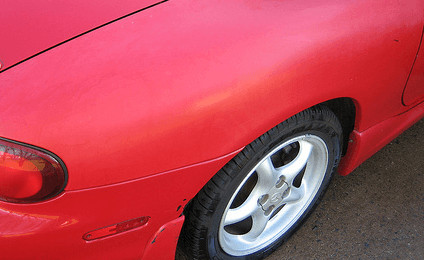 Dull oxidized Mazda Miata paint before restoration.
Dull oxidized Mazda Miata paint before restoration.
11.4 Case Study 4: Restored Mazda Miata Paint
After polishing, the Mazda Miata paint achieved full color, gloss, and depth. This photo showcases the effectiveness of proper polishing techniques in restoring oxidized paint.
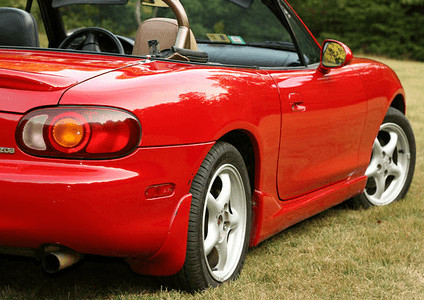 Mazda Miata paint with restored color, gloss, and depth after polishing.
Mazda Miata paint with restored color, gloss, and depth after polishing.
12. CARDIAGTECH.NET: Your Partner in Automotive Care
At CARDIAGTECH.NET, we understand the importance of maintaining your vehicle’s appearance. We offer a wide range of high-quality tools and equipment to help you fix oxidized car paint and keep your car looking its best. Our products are designed for both professionals and DIY enthusiasts, ensuring that you have the right tools for the job.
12.1 Our Product Range
- Polishers: We offer a variety of dual-action and rotary polishers from top brands.
- Compounds and Polishes: Our selection of compounds and polishes includes products for every level of oxidation.
- Pads and Accessories: We carry a wide range of polishing pads, microfiber towels, and other accessories.
- Sealants and Waxes: Our sealants and waxes provide long-lasting protection and enhance the shine of your paint.
- Detailing Kits: Our detailing kits include everything you need to get started with paint correction.
12.2 Why Choose CARDIAGTECH.NET?
- Quality Products: We only offer high-quality products from trusted brands.
- Expert Advice: Our team of experts is available to provide advice and support.
- Competitive Prices: We offer competitive prices on all of our products.
- Fast Shipping: We offer fast shipping to get you the products you need quickly.
- Customer Satisfaction: We are committed to customer satisfaction and offer a hassle-free return policy.
13. The Science Behind Paint Correction
13.1 How Polishing Works
Polishing involves using abrasive compounds to remove a thin layer of paint, leveling the surface and removing imperfections such as oxidation, swirl marks, and scratches. The process typically involves multiple steps, starting with a more aggressive compound to remove the damaged layer and finishing with a finer polish to refine the surface.
13.2 Understanding Abrasives
Abrasives are the key ingredient in compounds and polishes. They come in various sizes and types, each designed for a specific purpose. Common abrasives include:
- Aluminum Oxide: A common abrasive used in many compounds and polishes.
- Cerium Oxide: A fine abrasive used for polishing glass and delicate surfaces.
- Silicon Carbide: An aggressive abrasive used for heavy cutting.
13.3 The Importance of Pad Selection
The type of pad you use can significantly affect the results of polishing. Different pads have different levels of aggressiveness and are designed for specific compounds and polishes. Common pad types include:
- Foam Pads: Available in various densities, from cutting pads to polishing pads.
- Microfiber Pads: More aggressive than foam pads, ideal for heavy cutting.
- Wool Pads: The most aggressive type of pad, used for removing severe imperfections.
14. Cost Analysis of DIY vs. Professional Detailing
14.1 DIY Detailing Costs
The cost of DIY detailing can vary depending on the products and equipment you purchase. Here is a rough estimate:
| Item | Estimated Cost |
|---|---|
| Car Wash Soap | $10-20 |
| Clay Bar Kit | $20-40 |
| Dual-Action Polisher | $100-300 |
| Compounds and Polishes | $50-100 |
| Sealant and Wax | $30-50 |
| Microfiber Towels | $20-40 |
| Total | $230-560 |
14.2 Professional Detailing Costs
The cost of professional detailing can vary depending on the severity of the oxidation and the services offered. A typical paint correction service can range from $300 to $1000 or more.
14.3 Cost Comparison
While DIY detailing can be more affordable upfront, it requires an investment in equipment and time. Professional detailing offers the convenience of expert service and guaranteed results, but it comes at a higher cost.
15. Maintaining Your Car’s Finish in Different Climates
15.1 Hot and Sunny Climates
In hot and sunny climates, UV radiation is the primary concern. Regular waxing and sealing are essential to protect the paint from fading and oxidation. Consider using a ceramic coating for long-lasting protection.
15.2 Cold and Snowy Climates
In cold and snowy climates, road salts and de-icing chemicals can accelerate oxidation. Wash your car frequently to remove these contaminants and apply a durable wax or sealant.
15.3 Humid Climates
In humid climates, mold and mildew can grow on the paint surface. Wash your car regularly and use a car cover to prevent moisture buildup.
16. Innovations in Paint Protection Technology
16.1 Ceramic Coatings
Ceramic coatings are a relatively new technology that provides long-lasting protection and enhanced gloss. They form a chemical bond with the paint, creating a durable barrier against UV rays, scratches, and chemical damage.
16.2 Paint Protection Film (PPF)
Paint protection film (PPF) is a transparent film that is applied to the paint surface. It provides excellent protection against scratches, rock chips, and other types of damage.
16.3 Self-Healing Coatings
Self-healing coatings are a type of ceramic coating that can repair minor scratches and swirl marks. They contain polymers that can flow back into the scratch and level the surface.
17. Addressing Common Paint Problems
17.1 Swirl Marks
Swirl marks are fine scratches that appear as circular patterns on the paint surface. They are typically caused by improper washing and polishing techniques. To remove swirl marks, use a polishing compound and a dual-action polisher.
17.2 Water Spots
Water spots are mineral deposits that form on the paint surface when water evaporates. To remove water spots, use a water spot remover or a mild acid solution.
17.3 Bird Droppings
Bird droppings are highly acidic and can damage the paint if left on for too long. Remove bird droppings as soon as possible using a car wash soap and water.
17.4 Tree Sap
Tree sap is sticky and can be difficult to remove. Use a tree sap remover or a mixture of rubbing alcohol and water.
18. Eco-Friendly Car Care Practices
18.1 Waterless Washing
Waterless washing involves using a spray-on cleaner and microfiber towels to wash your car without using water. This is a great option for conserving water and reducing runoff.
18.2 Biodegradable Products
Use biodegradable car wash soaps, waxes, and sealants to reduce your environmental impact.
18.3 Proper Disposal
Dispose of used chemicals and polishing pads properly to prevent pollution.
19. The Future of Car Paint Technology
19.1 Self-Healing Paint
Self-healing paint is a technology that allows the paint to repair minor scratches and swirl marks automatically. This technology is still in its early stages, but it has the potential to revolutionize the car care industry.
19.2 Color-Changing Paint
Color-changing paint is a technology that allows the paint to change color on demand. This technology is based on electrochromic materials that change color when an electric current is applied.
19.3 3D-Printed Paint
3D-printed paint is a technology that allows car manufacturers to create custom paint finishes with intricate designs and patterns. This technology can be used to create unique and personalized car finishes.
20. FAQ: How to Fix Oxidized Car Paint
20.1 What is car paint oxidation?
Car paint oxidation is the deterioration of the paint’s surface due to exposure to oxygen, UV rays, and environmental pollutants, leading to a dull or chalky appearance.
20.2 How can I tell if my car paint is oxidized?
Signs of oxidation include dullness, chalkiness, fading, and a rough texture on the paint surface.
20.3 Can oxidized car paint be fixed?
Yes, mild to moderate oxidation can often be fixed with cleaning, polishing, and protecting the paint. Severe oxidation may require more aggressive techniques or repainting.
20.4 What tools do I need to fix oxidized car paint?
Essential tools include car wash soap, detailing clay bar, dual-action polisher, cutting compound, polishing compound, paint sealant, and car wax.
20.5 How often should I wax my car to prevent oxidation?
Waxing your car every 3-6 months can help protect the paint and prevent oxidation.
20.6 Is it better to fix oxidized car paint myself or hire a professional?
DIY is more affordable but requires time and equipment. Professional detailing offers expertise and guaranteed results but is more expensive.
20.7 Can I use a household cleaner to wash my car?
No, household cleaners can damage the paint. Use a pH-balanced car wash soap specifically designed for cars.
20.8 What is a dual-action polisher?
A dual-action polisher is a power tool used to polish car paint. It is safer and more user-friendly than a rotary polisher, reducing the risk of swirl marks.
20.9 How does polishing remove oxidation?
Polishing removes a thin layer of paint, leveling the surface and removing imperfections such as oxidation.
20.10 What is clear coat failure?
Clear coat failure is when the clear coat becomes severely damaged and begins to peel or flake off, often requiring repainting.
Oxidized car paint doesn’t have to be a permanent problem. With the right tools and techniques, you can restore your car’s shine and protect it from future damage. Visit CARDIAGTECH.NET today to find the equipment and supplies you need to keep your car looking its best.
Don’t let oxidized car paint diminish your vehicle’s appeal. Contact CARDIAGTECH.NET at 276 Reock St, City of Orange, NJ 07050, United States or Whatsapp: +1 (641) 206-8880 for expert advice and premium tools. Let us help you bring back that showroom shine. Visit our website at CARDIAGTECH.NET to learn more and place your order today.



